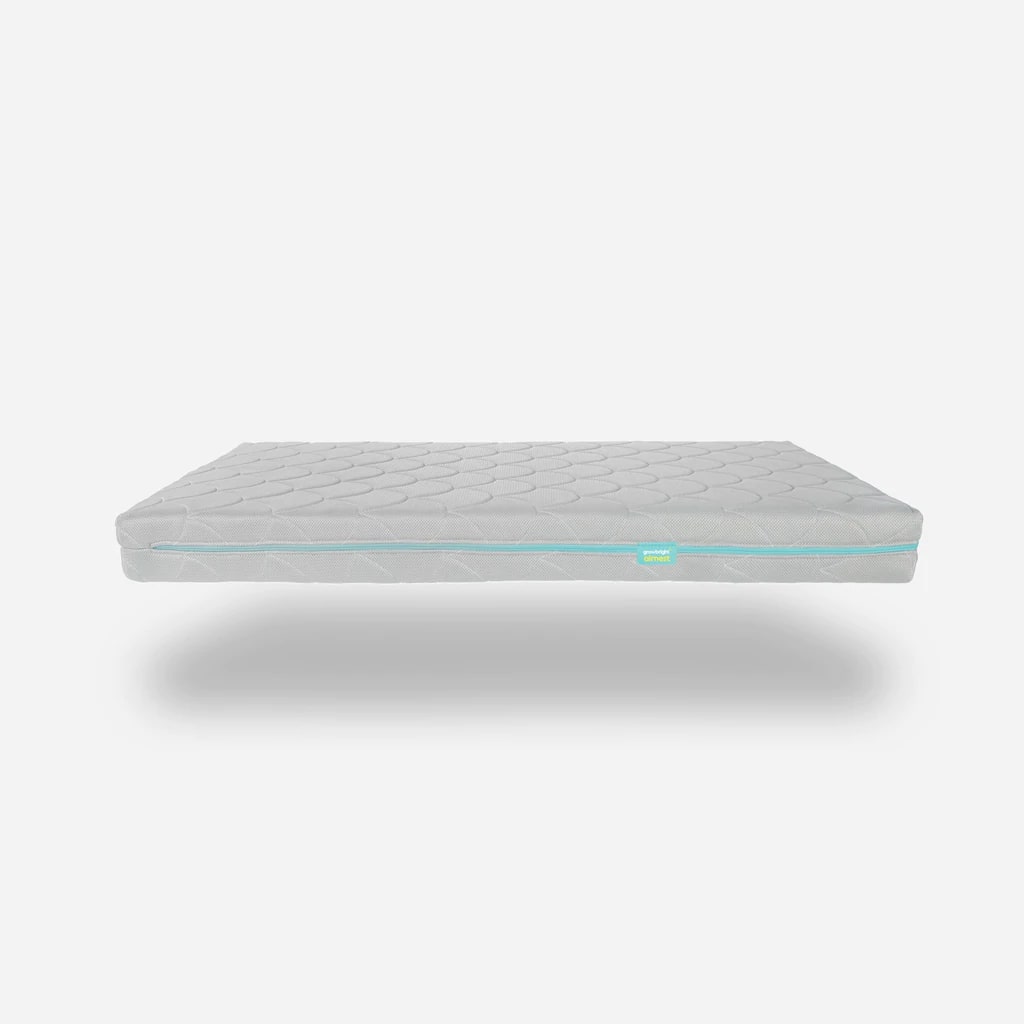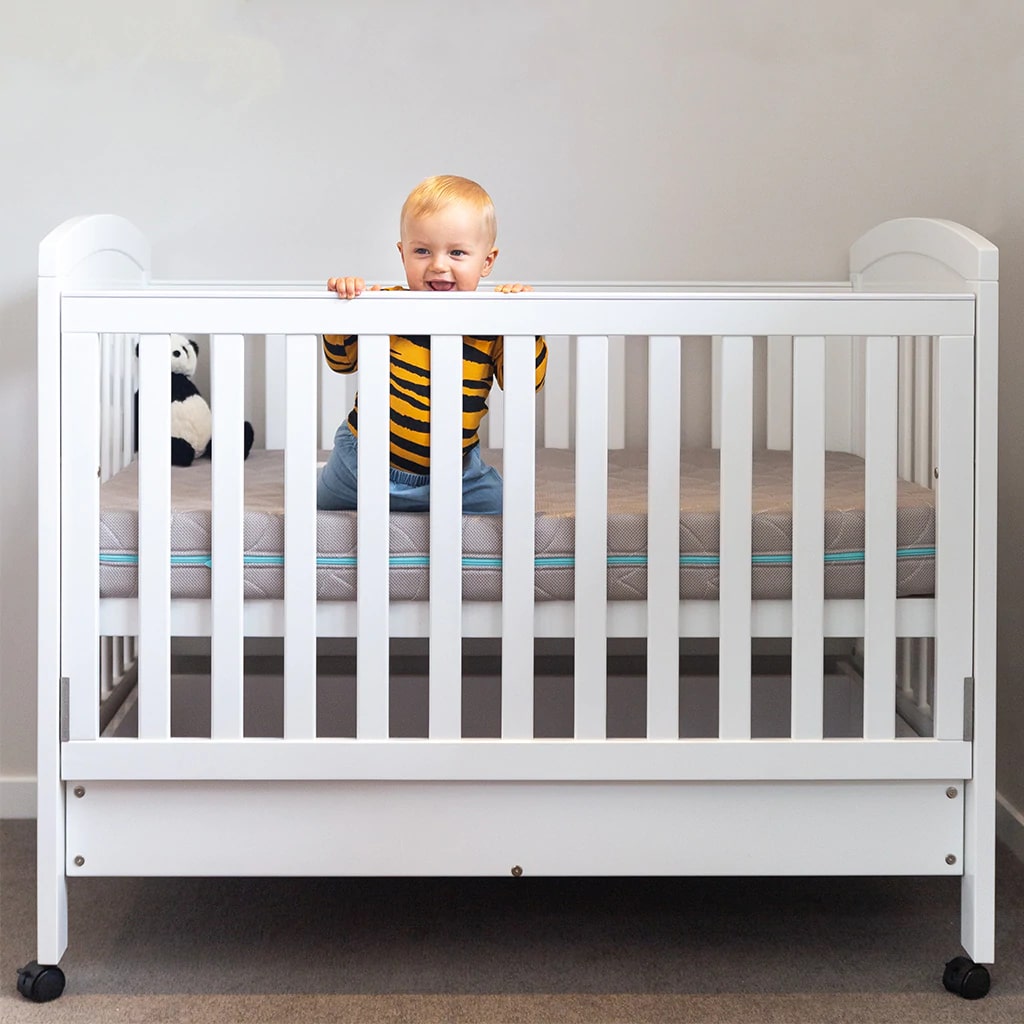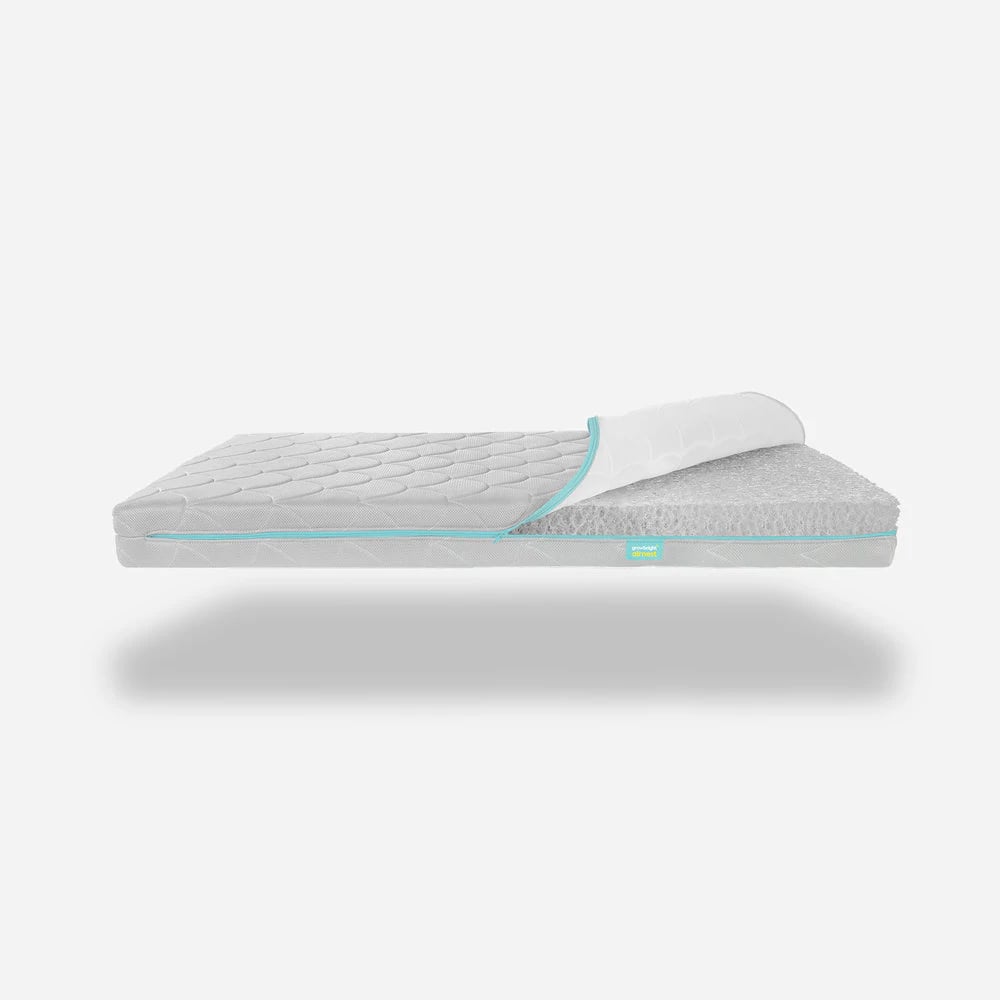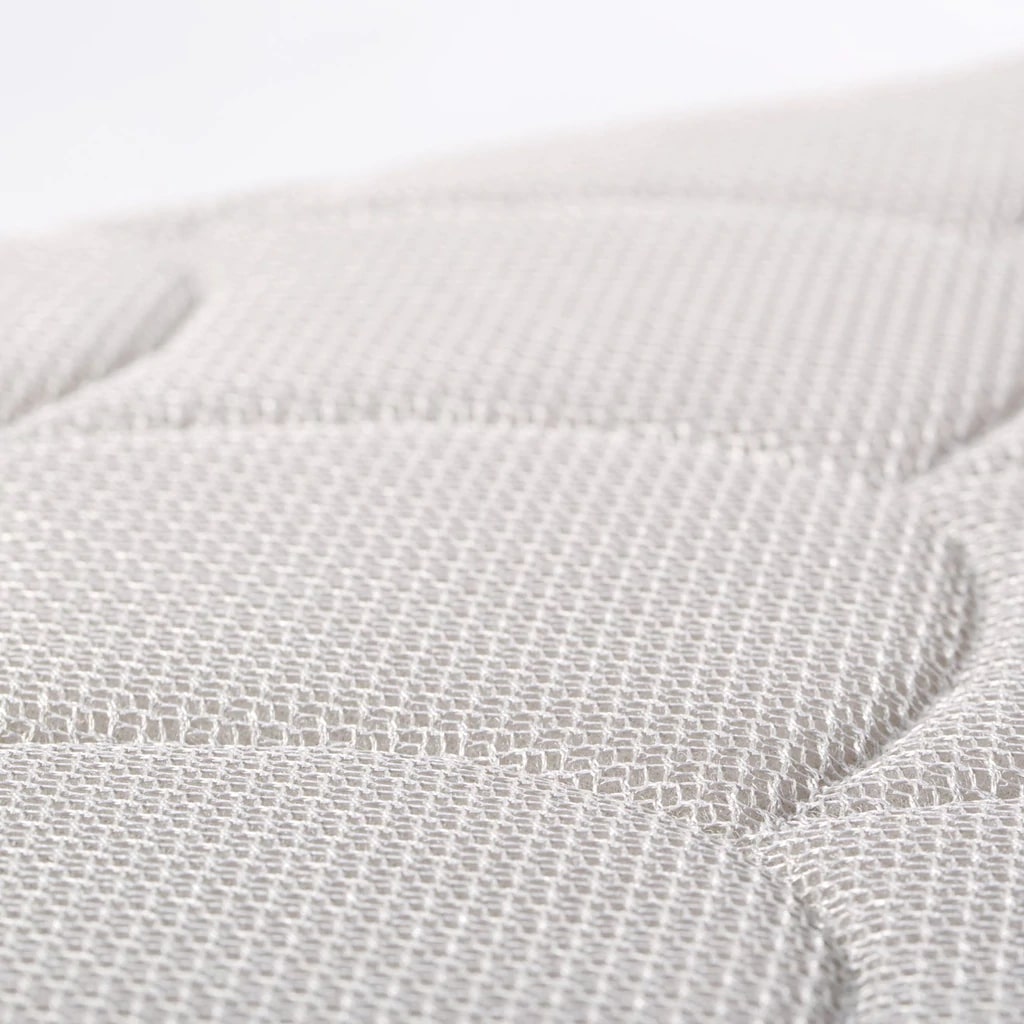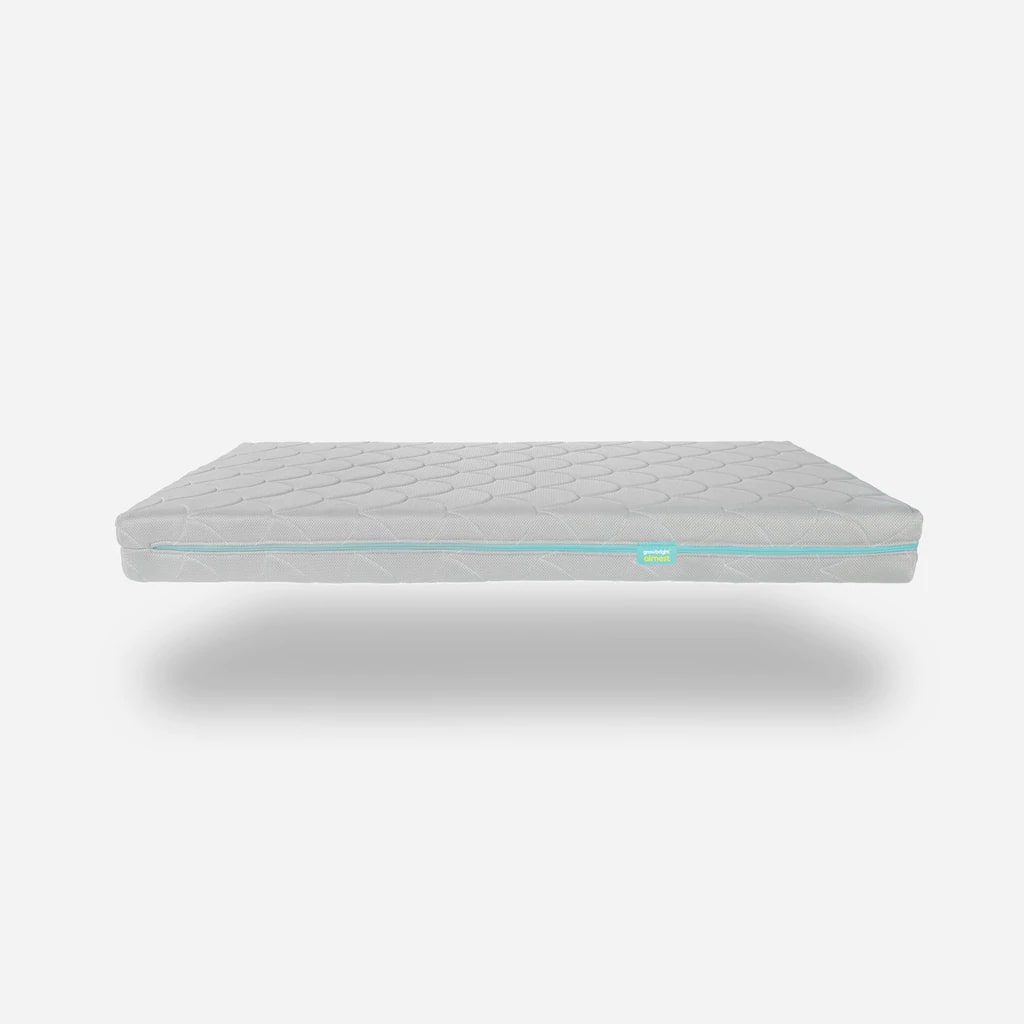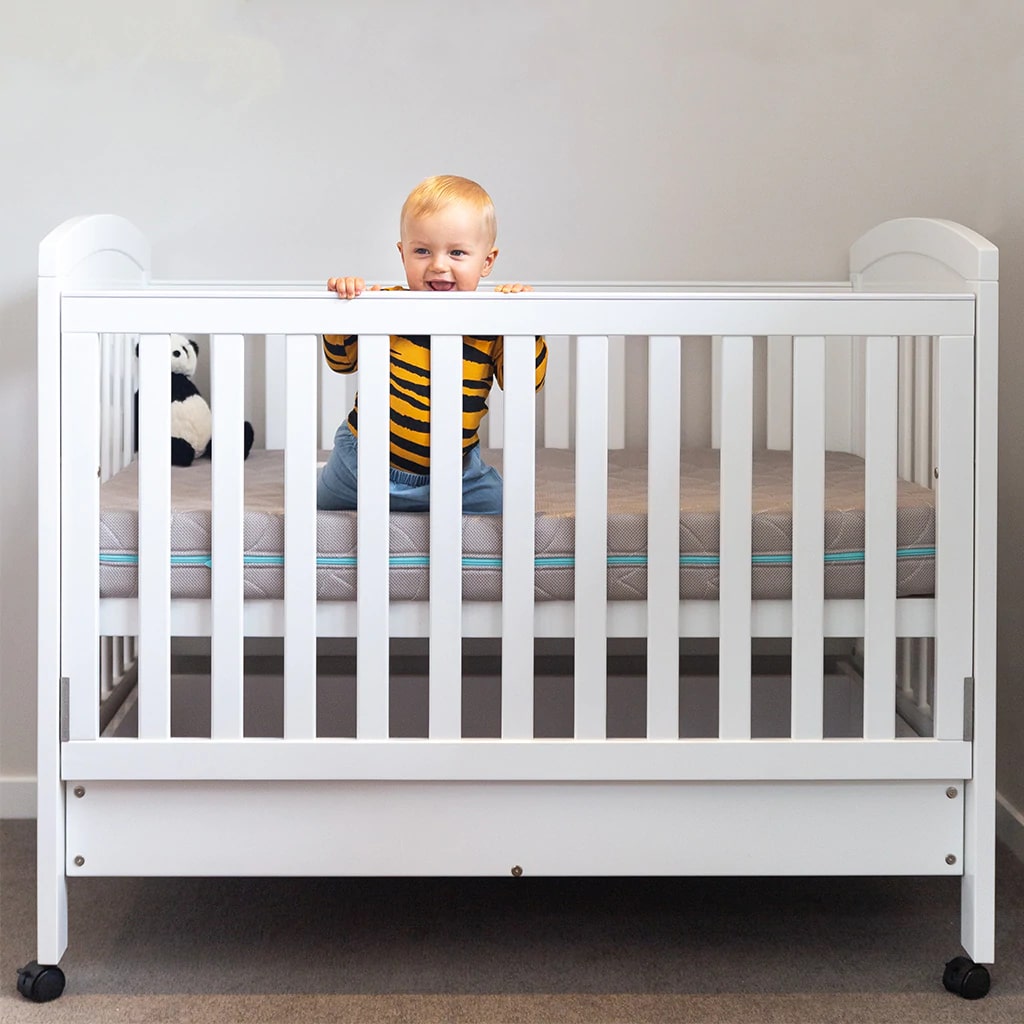Breathable Airnest Cot Mattress Standard 130x69
Breathable Airnest Cot Mattress Standard 130x69
SKU:30000744
Clothing Prem to 18 Months
| Size | Age Guide | Weight | Height |
|---|---|---|---|
| Premature | Premature or Small Newborn | Up to 4Kg | Up to 55cm |
| Newborn | 0-3 months | 4-6Kg | Up to 62cm |
| 3 Month | 3-6 months | 6-8Kg | Up to 68cm |
| 6 Month | 6-12 Month | 8-10Kg | Up to 76cm |
| 12 Month | 12-18 Month | 10-12Kg | Up to 84cm |
| 18 Month | 18-24 Month | 12-14Kg | Up to 92cm |
Clothing 2 to 6 Years
| Size | Age Guide | Height | Chest | Waist | Hip |
|---|---|---|---|---|---|
| 2 Year | 2-3 Years | Up to 100 cm | 56 | 51 | 58 |
| 3 Year | 3-4 Years | Up to 105 cm | 58 | 53 | 60 |
| 4 Year | 4-5 Years | Up to 110 cm | 60 | 55 | 62 |
| 5 Year | 5-6 Years | Up to 115 cm | 62 | 57 | 64 |
| 6 Year | 6-7 Years | Up to 120 cm | 64 | 59 | 66 |
Beanie Size Guide
| Size | Head Circumference | Age Guide |
|---|---|---|
| Premature | 31-35 cm | Premature or Small Newborn |
| Newborn | 35-40 cm | Newborn |
| Small | 40-43 cm | 3-6 Months |
| Medium | 43-47 cm | 6-18 Months |
| Large | 47-52 cm | 18-3 Years |
Sunhat Size Guide
| Size | Head Circumference | Age Guide |
|---|---|---|
| Newborn | 37-40 cm | Newborn |
| Small | 40-43 cm | 3-6 Months |
| Medium | 43-46 cm | 6-12 Months |
| Large | 46-49 cm | 12-24 Months |
| Xtra Large | 49-54 cm | 2-4 Years |
Sleep Pods Size Guide
| Size | Weight | Age Guide | Measurement(Back to Hem) |
|---|---|---|---|
| Newborn | 0-6 kgs | 0-3 Months | 60.5 cm |
| Small | 0-8 kgs | 3-6 Months | 66 cm |
Booties Size Guide
| Size | Age Guide |
|---|---|
| Newborn | 0-3 Months |
| Small | 3-6 Months |
| Medium | 6-12 Months |
| Large | 12-18 Months |
Pretty Brave Baby
| Foot Length (mm) | Insole Length (mm) | EU | UK | Age | INT |
|---|---|---|---|---|---|
| 95-104 | 110 | 16/17 | 2 | 0-6m | S |
| 104-114 | 118 | 18 | 3 | 6-12m | M |
| 114-123 | 127 | 19/20 | 4.5 | 12-18m | L |
| 123-137 | 142 | 21/22 | 5.5 | 16-22m | XL |
Pretty Brave 1st Walker
| Foot Length (mm) | Insole Length (mm) | EU | UK | Age |
|---|---|---|---|---|
| 114-120 | 125-128 | 19 | 3 | 1 yr |
| 120-126 | 132-135 | 20 | 3.5 | 1-2 yrs |
| 126-132 | 138.5-141.5 | 21 | 4.5 | 1-2 yrs |
| 132-138 | 145-148.5 | 22 | 5 | 2 yrs |
Crywolf Swim Nappy
| Size | Length (waist to crotch) | Crotch Width (side to side) |
|---|---|---|
| 0-1 yr | 1-2 yrs | |
| 37 | 38 | |
| 14.5 | 15.5 |
Crywolf Rash Suit
| Size | Length (back neck to crotch) | Chest (arm to arm) | Waist (side to side) | Sleeve (neck to cuff) | Neck Opening(diameter) |
|---|---|---|---|---|---|
| 6-12 Months | 1 yr | 2 yrs | 3 yrs | ||
| 40 | 42 | 44 | 46 | ||
| 25 | 26 | 27 | 28 | ||
| 24 | 25 | 26 | 27 | ||
| 30 | 31.5 | 33 | 34.5 | ||
| 13.25 | 13.25 | 13.8 | 14.3 |
In stock
Couldn't load pickup availability
Overview
Overview
The Growbright Airnest Cot Mattress is designed to give your baby the safest, cleanest, and most comfortable sleep possible while giving you total peace of mind.
Made with an absolutely revolutionary airnest core, and a spill-resistant, washable cover - this mattress is 100% washable from surface to core, drying quickly at home so you can keep germs, allergens, and mould at bay.
With market-leading breathability, Airnest technology helps regulate your baby’s temperature and reduces the risk of overheating or airway obstruction, even if they roll over during sleep.
Lightweight, hypoallergenic, and free from foams, adhesives, and off-gassing nasties, the airnest mattress is as pure as it is practical. Its balance of firmness and softness provides optimal comfort for growing bodies, and with a durable, recyclable design, it can be reused for a second child without worry.
Suitable from newborn through to when your little one transitions to a bed, the Growbright airnest Cot Mattress is the breathable, supportive, and sustainable choice for safer sleep.
What's Included
What's Included
Technical Specification
Technical Specification
User Guide
User Guide
Delivery and Returns
Delivery and Returns
- Delivery: Free within NZ on orders over $100 (excluding bulky items) or $8 standard shipping
- Returns: Accepted within 14 days of receipt with proof of purchase
- Some items are excluded from returns including sale items, hardware, car seats, prams, monitors and personal items - please click here for the full list.
Share this product
Recently Viewed Products
Related Blogs
How to make a cute, cosy and safe baby bed
Here’s what you really need to know about safe sleep It’s easy to get caught up in the dreamy images of babies curled up in plush bedding, surrounded by teddies and soft textures. But when it comes to real-life safe sleep, less is definitely more. Whether you’re still setting up the nursery or your baby is already here, creating a secure and snuggly sleep space is one of the best things you can do for their wellbeing - and your peace of mind. Understanding SUDI SUDI stands for Sudden Unexpected Death in Infancy, and while it sounds confronting, knowing the facts can be empowering. SUDI includes deaths from a range of sleep-related causes, including accidental suffocation and unexplained deaths (previously called SIDS). In New Zealand, it’s one of the most common causes of death for babies under one—but the good news is, there’s a lot we can do to reduce the risk. Research shows that a baby’s sleep environment plays a big role. Things like sleeping baby on their back, using a firm mattress, avoiding overheating, and keeping their sleep space free from loose items all help create a safe place for them to rest. SUDI is most likely to occur between 2 and 4 months, so starting safe sleep habits from day one is key. By following a few simple guidelines and making thoughtful choices around where and how your baby sleeps, you're helping create the safest possible start. Safe sleep isn’t about fear—it’s about giving your baby the best chance to thrive. Safe sleep basics: what to know One of the most important ways to reduce the risk of SUDI is to make sure your baby sleeps on their back, in their own bed, and in the same room as you for at least the first six months. Their sleep space should be simple, uncluttered, and specifically designed for babies. Keep your home smokefree, avoiding overheating, and ensuring your baby’s face remains uncovered during sleep. Here’s what that looks like in practice: Choose a compliant cot A safe night’s sleep starts with a compliant cot. In New Zealand, all cots must meet the AS/NZS 2172 safety standard, which covers features like the minimum depth, spacing between slats, and secure construction. Look for the safety label when buying, and avoid using broken or modified cots - even hand-me-downs. Having baby in their own cot or bassinet reduces the risk of accidental suffocation and overheating. Shop our safe and gorgeous range of bassinets and cots here. Pick a firm, snug-fitting mattress A firm mattress that fits tightly within the cot frame is essential to prevent your baby’s face from pressing into soft surfaces or becoming wedged in gaps. The mattress should be flat and supportive - not shaped or elevated, and free of damage. Bonus points for breathable materials and easy-clean features, especially if you’re dealing with frequent night-time messes. We stock several options that will keep your baby safe. Shop here. Stick to the essentials To keep your baby cosy and safe, layer their sleep space with: Waterproof mattress protector – Ideal for leaks and spills, a protector helps keep the mattress clean and hygienic. Choose breathable options like merino for added comfort. Fitted sheet – This is where you can add your splash of style. Soft, well-fitted cotton or merino sheets keep things simple and sweet without compromising safety. Swaddle or sleeping bag – Skip the loose blankets. Swaddling (if age-appropriate) or using a well-fitting sleeping bag helps regulate baby’s temperature without the risk of fabric covering their face. What not to include Soft toys, bumpers, loose blankets, pillows, or positioners should never be in the cot. These items, while cute, can increase the risk of suffocation. Even mobiles and cords should be securely out of reach. The safest bed is a clear one - nothing but baby, dressed for the room’s temperature, on their back. Monitor with peace of mind If it helps you rest easier, consider a reliable video or breathing monitor. While not essential, these can offer extra reassurance during naps and overnight, especially during the early months. Shop our range of monitors here A minimalist bed is a safe bed We know it might feel counterintuitive when you’re eager to make your baby’s space feel warm and welcoming. But safety should always come before styling. Keep it simple until your little one is at least 12 months old, when they’re better able to move around and regulate their temperature.
Learn moreReduce the Risk of SIDS
How to help keep your baby safe Entering the world of parenthood comes with its fair share of anxiety, from wondering how different your new life will be, to the worry of being responsible for a new little person. Sudden infant death syndrome (SIDS), previously known as ‘cot death’, is the unexplained death (typically during sleep) of a seemingly healthy baby. While SIDS is a very real threat, with a little knowledge you can reduce many known contributing factors. Back to sleep You’ll no doubt hear this on repeat from midwives and Plunket nurses as soon as your little babe comes along and for very good reason. Babies who sleep on their stomachs are much more at risk of SIDS. While it’s not 100% understood exactly why experts believe it could be about re-inhaling stale air. Once your baby can happily roll over by themself, you don’t need to worry about sleeping positions any more. Make it a strictly smoke-free zone Smoking (and exposure to second-hand smoke) during pregnancy not only puts your baby at risk of health issues but increases the risk of SIDS too. It’s thought that nicotine can wreak havoc on a mechanism in their brain which senses a lack of oxygen and triggers breathing to start (called auto-resuscitation). So make sure it’s strictly a smoke-free zone when you’re pregnant and when your little one arrives, and that your family and friends are on board too. Welcome your new (temporary) roommate It’s widely recommended that your new babe bunks in with you (in their own safe sleeping space) for at least the first four to six months. This isn’t always practical for light sleepers, in which case a good breathing movement monitor set up in their nursery will give you peace of mind. A safe spot for slumber While room-sharing is recommended, bed-sharing isn’t. It can be so tempting to savour that extra time snuggled up in bed with your new babe, but bulky duvets, pillows and even an adult rolling can spell danger for little ones. Setting your baby up with their own safe space (like a portable Moses basket ) within arm’s reach is your best option. Be prepared to be suddenly jolted awake and find yourself sitting up in bed or a nursing chair with your baby in your arms – sleep deprivation can really grab hold of you in the early days. Sleeping with a baby on a chair or sofa is very dangerous, so to avoid this as much as possible, use the middle-of-the-night feeds as opportunities to clear out and edit that day’s photos on your phone (no doubt there will be plenty!) Your phone’s blue light will help keep you alert. Baby, it’s cold outside It’s important to make sure the room where your baby is sleeping is at a comfortable temperature. Bundling up babies at all times is an outdated theory – overheating is another substantial SIDS risk. Higher temperatures can put babies into a deeper slumber, making it difficult for them to wake if their breathing is obstructed. The recommended room temperature for a baby is 16 to 20 degrees, with around 18 degrees being ideal. To check your baby’s temperature, feel his back or tummy – it should feel warm. A great way to check the temperature of their nursery is with a combined nightlight/temperature sensor like the Moon Nightlight . Blankets (and everything else) be gone All those cute blankets, animal-shaped pillows and snuggly little toys that create a cosy-looking cot will need to stay in storage until your baby’s first birthday. Until then, all you need is a fitted sheet and wearable bedding like a Merino Sleep Pod to keep them warm. The key is to avoid anything that may cover their face and restrict breathing. Breastfeed if possible Experts aren’t sure why, but breastfeeding can significantly lower the risk of SIDS. The theory is that breastfeeding promotes the sucking and swallowing action, which develops muscles that keep the airway open while boosting brain development. Breastfed babies are generally lighter sleepers, too. This might not sound like a benefit at 2 am, but anything that helps reduce SIDS is a big plus. A big tick for pacifiers There tends to be negativity around using pacifiers, but they can not only be life-saving for unsettled babies during car trips, but also literally life-saving. Once again, it’s a bit of an unknown how pacifiers help, but there is a clear link – babies who use pacifiers are at lower risk of SIDS. As with breastfeeding, this could be due to more developed sucking and swallowing muscles that help keep airways open. If you’re breastfeeding, wait until this is well established (at least 4-6 weeks) before introducing a good quality silicone pacifier . Do what you can to reduce the risk While there are still a lot of unknowns with SIDS, being armed with what you can do to reduce as many risks as possible should put your mind at ease. Keep in mind that the risk of SIDS decreases after six months and is pretty rare after a baby’s first birthday.
Learn moreIntroducing a bedtime routine with your baby
The Power of a Bedtime Routine for Your BabySimple rhythms that lead to better sleep - for both of you In the early weeks with a newborn, life tends to move to a rhythm all on its own. Feeds, naps, cuddles, and nappy changes often blur into one another, and any sense of routine can feel a little out of reach. That’s completely normal! As your baby grows, you’ll notice more predictable patterns beginning to emerge. This is the perfect time to gently introduce a bedtime routine – a simple series of calming steps that helps your baby unwind and gives you both a peaceful finish to the day. Why bedtime routines matter Babies thrive on repetition. A consistent series of calming activities each evening helps regulate their body clock, encourages longer stretches of sleep, and creates a comforting rhythm to the day. Routines don’t just benefit sleep - they also nurture connection, ease overstimulation, and make bedtime feel less like a battle and more like a shared moment of calm. These rituals will evolve as your baby grows, but the sense of structure and predictability will continue to support their development well into childhood. When to begin You can begin easing into a bedtime routine from around six to eight weeks old - once your baby begins to show more consistent sleep and feeding patterns. This is also when they start to recognise daily cues, making it the perfect time to introduce a gentle ritual that helps them wind down. How to get started There’s no “perfect” routine - what works for one family might not suit another. The key is consistency, calmness, and keeping things relatively short (20 to 30 minutes is ideal). Try to carry out most of the routine in your baby’s room so they start to associate the space with sleep. Here’s a sample rhythm to get you started: Bath - A warm bath helps wash away the day and begins the wind-down process. This can also be a fun and playful moment, especially if older siblings are involved. Massage - After bath time, a quick massage with something like Scullys Baby Massage Oil can help your baby get ready for rest. This is a wonderful way to connect with your baby through touch, as well as being very relaxing for both of you. Sleepwear - Soft, breathable pyjamas or a sleeping gown signal that bedtime is near. You might like to use Merino to help regulate temperature throughout the night. We have a gorgeous range of safe and cosy sleepwear available here. Feeding - Try offering the final feed early in the routine rather than just before sleep. This can help reduce reliance on feeding to fall asleep. Story or song - A simple board book, soft lullaby, or even humming a tune gives your baby a consistent cue that bedtime is here. It also builds language skills and creates special bonding moments. Cuddles - A warm snuggle and quiet kiss goodnight helps your baby feel safe, even if you’ll likely see them again overnight. Watch for sleepy cues Rather than watching the clock, keep an eye on your baby. Rubbing eyes, zoning out, yawning, or fussing can all signal tiredness. Aim to start the bedtime routine before they become overtired. For most babies, somewhere between 6:30 and 7:30 pm works well, and this timing can continue into the early school years. Keep the environment sleep-friendly A dark, quiet space tells your baby’s brain that it’s time to sleep. Avoid bright lights, noisy toys, or too much stimulation. Night lights can be helpful for feeding and changes, but aren’t necessary for sleep - babies aren’t born afraid of the dark. You could add a soft and practical sleep sound machine, like a Yogasleep Nod to make night-time care easier with it's built in night light. Put baby to bed drowsy, not asleep As you get to know your baby’s cues, try placing them into bed when they’re sleepy but still awake. This helps them learn to settle themselves, which can make overnight waking easier to manage. It also reduces the shock of waking up in a different spot from where they fell asleep. Be consistent - but stay flexible Consistency is key, but so is flexibility. There’ll be times when travel, illness, or overtired evenings throw things off. The idea is to have a calming, repeatable routine you can come back to, wherever you are. If more than one caregiver can do bedtime, that helps too - it builds flexibility and avoids babies becoming dependent on one specific parent for settling. Small rituals with lasting benefits Your baby’s routine doesn’t need to be perfect, and it will change over time. But these small, daily rhythms bring more than just sleep - they offer connection, confidence, and a peaceful way to end the day together. One day, your baby will be reading their own book at bedtime. But your cuddle and goodnight kiss? That will still matter, even if you have to sneak it in after lights out ❤️
Learn moreBaby Comforters: What Are They, and How To Introduce Them
There’s something very special about watching your baby snuggle into their favourite little blanket or soft toy. For many little ones, a comforter (or blankie) becomes more than just a bedtime accessory - it’s a trusted friend that brings a sense of calm and reassurance through every new stage of growing up.
Learn more

